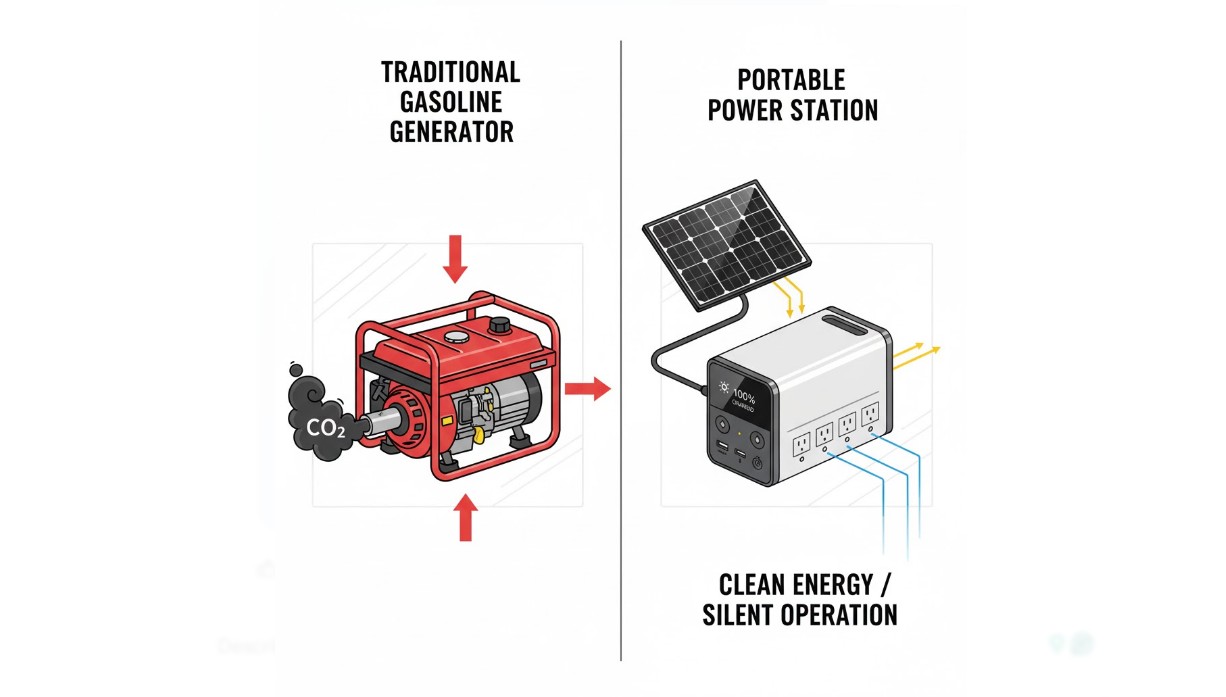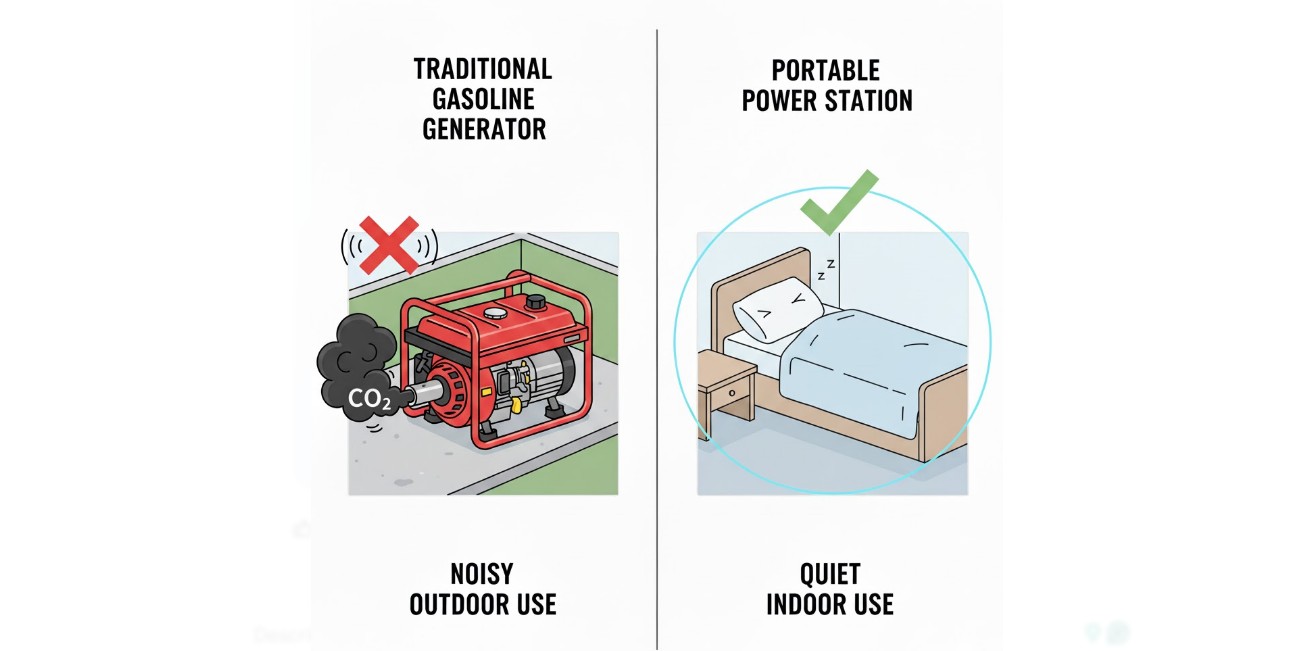The modern world runs on electricity, and the thought of a prolonged power outage—whether due to a severe storm, grid failure, or simply being off-grid—is a source of anxiety for many. Historically, the portable generator reigned supreme as the go-to backup power solution. These combustion engine workhorses have faithfully kept refrigerators running and lights on for decades. However, a powerful, silent, and emission-free contender has emerged: the portable power station.
Today, homeowners, RV enthusiasts, and outdoor adventurers face a fundamental decision: Should you rely on the proven, high-output power of a traditional, fuel-burning generator, or embrace the clean, convenient, and evolving technology of a battery-powered power station? The choice isn’t just about price; it’s about matching a device’s core functionality to your specific power needs, environmental concerns, and tolerance for noise and maintenance. Both machines deliver electricity, but they achieve this goal in fundamentally different ways, resulting in vastly different user experiences and applications. This comprehensive guide will dissect the technical, practical, and financial differences between power stations vs generators, providing you with the clarity needed to make the optimal investment for your peace of mind.
The Fundamental Difference: Generation vs. Storage—The Core Technology
To truly understand the pros and cons of each device, we must first look at the principle by which they provide electricity. This is the single most important technical distinction between the two technologies.
Portable Generators: The Real-Time Powerhouse
A portable generator is, first and foremost, a machine designed to generate electricity in real-time. It uses an internal combustion engine (running on fuels like gasoline, propane, or diesel) to convert chemical energy into mechanical energy, which then spins an alternator to produce AC (Alternating Current) electricity. In simpler terms, it’s a small, standalone power plant. Consequently, as long as you can feed the engine fuel and oil, the unit can theoretically run non-stop.
- Mechanism: Chemical energy (fuel) $\to$ Mechanical energy (engine) $\to$ Electrical energy (alternator).
- Output: Continuous, high-wattage output determined by engine size.
- Runtime: Limited only by the availability of fuel.
- Types: Conventional (higher THD) and Inverter Generators (cleaner power, more fuel-efficient).
Portable Power Stations: The Stored Energy Solution
In contrast, a portable power station (often incorrectly called a battery or solar generator) does not generate power itself; it stores it. These units consist of a large, rechargeable lithium-ion battery (like LiFePO4), a sophisticated Battery Management System (BMS), and a built-in pure sine wave inverter. The unit must be charged beforehand using an external source—such as a wall outlet, a car, or compatible solar panels—before it can deliver power. When you turn it on, the battery’s stored DC (Direct Current) energy is converted by the inverter into usable AC power.
- Mechanism: Electrical energy (stored in battery) $\to$ Electrical energy (AC output via inverter).
- Output: Finite, limited by battery capacity (measured in Watt-hours, Wh).
- Runtime: Limited by the battery charge and the draw of connected devices.
- Key Feature: Built-in inverter for clean, stable power, essential for sensitive electronics.

Comparison Metric 1: Power Output and Runtime—High Watts vs. Long Endurance
The first practical consideration for any backup power device is its ability to handle your necessary electrical load, followed closely by how long it can sustain that load.
Raw Power Capacity: Generators Dominate
In the realm of raw power, portable generators remain the undisputed champions. Their output is a function of the engine size, and high-end consumer models can easily produce continuous power in the range of 5,000 to 15,000 running watts. This massive output is crucial for powering high-demand appliances simultaneously, such as a central air conditioner, well pump, electric oven, or running multiple high-amperage power tools on a job site.
By contrast, portable power stations are limited by the capacity of their inverter and battery. Most common models range from 500W to 3,000W, with specialized, expensive units pushing up to 4,000W or 5,000W. While a 3,000W power station is perfectly capable of running a refrigerator, lights, and small electronics, it typically cannot handle the surge or continuous power required for a major home appliance like a central AC unit or a large home workshop.
Runtime and Recharge: The Endurance Trade-Off
The key differentiator in long-duration use is the fuel source. A generator can run indefinitely as long as you have fuel on hand. With fuel-efficient inverter technology or dual/tri-fuel options (see more on generator fuel types here), a generator can be an excellent choice for multi-day outages.
A power station, however, is limited by its finite battery capacity. A 2,000Wh battery running a 200W load will last approximately 10 hours. Once depleted, it must be recharged. While modern power stations offer fast-charging (AC wall outlet), solar recharging can be significantly slower, sometimes taking an entire day of peak sunlight to fully replenish a large battery bank. This creates a critical question: Is your power requirement measured in hours or days?
Comparison Metric 2: Safety, Noise, and Environmental Impact—Clean and Quiet vs. Fumes and Fury
Beyond raw power, the operational characteristics of the device—particularly safety and noise—significantly impact the user experience, especially in residential or close-quarters settings.
Safety, Emissions, and Indoor Use
The single most dangerous aspect of a traditional generator is the production of carbon monoxide (CO). As an odorless, colorless, and deadly gas, this necessitates that all combustion-engine generators must be operated outdoors and far away from any doors or windows. This severely restricts placement and adds a layer of operational complexity and risk.
Conversely, a portable power station is a clean energy device. Since it operates entirely on stored battery power, it produces zero emissions and no hazardous fumes. This critical difference means power stations can be used safely indoors, making them perfect for apartments, small homes, RVs, and running medical equipment (like CPAP machines) in a bedroom during the night.
Noise Levels: Silent Operation Wins
The engine required to run a conventional generator is inherently noisy, often operating between 65 to 85 decibels (dBA)—comparable to a vacuum cleaner or loud street traffic. Even modern inverter generators only manage to reduce this to the mid-50s to low-60s dBA, which can still be disruptive in a quiet neighborhood or campsite.
The power station, having no combustion engine, operates in near-total silence. The only noise is a minimal hum from the internal fan, which is only noticeable when the unit is under heavy load. This silence premium is a massive advantage for camping, recreational vehicle (RV) use, and urban home backup, significantly improving quality of life during an outage.

Comparison Metric 3: Cost, Maintenance, and Longevity—Upfront Investment vs. Long-Term Expenses
The financial aspect involves more than just the purchase price; it includes running costs and the maintenance required over the life of the unit.
Initial Purchase Price
Generally, a basic, lower-wattage conventional generator has a lower initial purchase price than a comparable low-capacity portable power station. However, as you scale up in power, the lines blur. A high-wattage inverter generator or a premium home backup generator can easily cost as much as or more than a large-capacity power station.
Running and Maintenance Costs
This is where the financial models diverge sharply:
- Generators: Have high ongoing costs. You must constantly purchase, transport, and safely store fuel, which can be expensive and logistically challenging during an emergency. Furthermore, a combustion engine requires regular maintenance—oil changes, spark plug checks, filter replacements, and carburetor cleaning—all of which add time and expense over the unit’s lifespan.
- Power Stations: Have minimal ongoing costs. They rely on “free” power if charged via solar panels, or the relatively low cost of grid electricity. Maintenance is virtually non-existent—no oil, no fuel, and no moving engine parts to service.
Longevity: Battery Cycles vs. Engine Hours
A high-quality generator can last for 10 to 20 years if properly maintained, typically measured by a total number of operating hours (e.g., 2,000 to 5,000 hours). Its life is dependent on rigorous maintenance.
A power station’s life is measured in battery cycles. Modern LiFePO4 batteries are highly durable, often rated for 3,000+ charge cycles before dropping to 80% of their original capacity. This can translate to a lifespan of 5 to 10 years, depending on usage frequency. While the entire unit is rendered less effective as the battery degrades, the lack of mechanical parts often means higher reliability during operation.
The Ultimate Breakdown: Portable Power Station vs. Generator
To summarize the complex decision, here is a comparative table of the critical factors:
| Feature | Portable Generator (Fuel-Based) | Portable Power Station (Battery-Based) |
|---|---|---|
| Power Source | Gasoline, Propane, Diesel (Combustion) | Rechargeable Battery (Li-ion, LiFePO4) |
| Power Output (Watts) | Very High (5,000W – 15,000W+) | Low to Medium (500W – 4,000W max) |
| Runtime | Very Long, continuous (Fuel limited) | Finite (Battery capacity limited) |
| Safety/Emissions | High risk (Carbon Monoxide). Must be used outdoors. | Zero Emissions. Safe for indoor use. |
| Noise Level (dBA) | Loud (65-85 dBA) | Silent (Fan noise only) |
| Maintenance | High (Oil, filters, fuel, spark plugs) | Minimal (Battery cycling, cleaning) |
| Recharge/Refuel | Fast (Refueling tank) | Slow (Hours via AC/Solar) |
| Portability | Bulky and Heavy (often on wheels) | Lightweight and Compact (handle/carry) |
The table clearly illustrates the trade-off: Generators offer power and duration at the expense of noise, emissions, and maintenance. Power Stations offer safety, convenience, and silence at the expense of raw power output and continuous run time.
Making the Final Choice: Which Solution Is Right for You?
The “better” option is entirely dependent on your primary application. Analyze your intended use scenario carefully.
Choose a Portable Generator If…
- You Need to Power Major Appliances: Your primary goal is to keep high-demand items like a well pump, central heating fan, air conditioning unit, or electric range operational.
- You Face Extended, Multi-Day Outages: You live in an area prone to severe weather events where power can be out for days or weeks. The ability to simply add more fuel for continuous run time is non-negotiable.
- Your Primary Use is on a Job Site: You need high-amperage, continuous power for heavy-duty tools like welders, miter saws, air compressors, and mixers.
Choose a Portable Power Station If…
- You Require Quiet, Indoor Power: You need to run medical equipment (like a CPAP machine), charge essential electronics, or power a refrigerator in an apartment or close-quarters setting where noise and fumes are unacceptable.
- Your Outages are Short-Term (Under 12 Hours): You need a quick, reliable solution for short blackouts that can keep the essential electronics, lights, and one refrigerator running until the grid is restored.
- You Prioritize Portability and Ease of Use: For camping, van life, tailgating, or remote photography, a lightweight, plug-and-play device that requires zero prep or fueling is ideal.
- You Value an Eco-Friendly Footprint: Charging via solar panels aligns with a sustainable, zero-emission lifestyle.
The Hybrid Solution: The Best of Both Worlds
Increasingly, the most robust home backup strategy involves a combination of both technologies. The power station handles the initial, short-term outage: it’s silent, requires no setup, and keeps critical electronics and the refrigerator running. If the outage extends beyond 8-12 hours, the generator can then be deployed for its high-wattage capacity and long runtime, even being used to recharge the power station quickly before being shut down to conserve fuel.
Final Thoughts
The rise of the portable power station is a testament to the pace of battery and inverter technology, providing a truly viable, clean, and silent alternative to the traditional generator. No longer are consumers forced to choose the “lesser of two evils.” Instead, the choice between power stations vs generators is now a strategic calculation based purely on need.
For the user whose main concern is long-term survival of a whole-home system or industrial-grade power for a job site, the fuel-powered generator remains the most practical and cost-effective choice for its raw capacity and unlimited duration. However, for the majority of modern homeowners and recreational users who prioritize safety, convenience, silence, and clean power for their sensitive electronics, the portable power station—especially when paired with solar charging—is rapidly becoming the superior, more elegant solution. Ultimately, the best power solution is the one that is readily available, simple to operate, and perfectly matched to the critical loads you need to sustain.
Amranul is a highly experienced product review writer with a passion for helping readers make smart, informed purchasing decisions. Since 2018, he has specialized in thoroughly researching and analyzing a wide range of products to deliver honest, in-depth reviews. Amranul combines technical accuracy with clear, engaging writing to break down complex product features and highlight true user value. Look for his reviews to find reliable information and expert insights you can trust before you buy!





